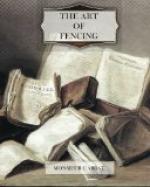The Sword, since it’s first Invention, has been used in different Manners: First, with a Shield or Buckler; Secondly, with a Helmet, and Thirdly, with a Dagger, which is still used in Spain and Italy. Mr. Patinotris, who taught at Rome, introduced, and laid down Rules for the Use of the Small Sword alone, which has since been much improved by the French and our Nations.
As the Art of Fencing consists in attacking and defending with the Sword, it is necessary that every Motion and Situation tend to these two principal Points, viz. In offending to be defended, and in defending to be in an immediate Condition to offend.
There is no Guard but has it’s Thrust, and no Thrust without it’s Parade, no Parade without it’s Feint, no Feint without it’s opposite Time or Motion, no opposite Time or Motion but has it’s Counter, and there is even a Counter to that Counter.
Some injudicious Persons have objected to Mr. L’abbat’s Manner of Fencing, that it is too beautiful and nice, without observing that if it be beautiful, it cannot be dangerous, Beauty consisting in Rule, and Rule in the Safety of attacking and defending.
In Fencing, there are five Figures of the Wrist, viz. Prime, Seconde, Tierce, Quart, and Quinte. The first is of very little Use, and the last of none at all.
Prime is the Figure that the Wrist is in, in drawing the Sword. Seconde and Tierce require one and the same Figure of the Wrist, with this Difference only, that in Seconde, the Wrist must be raised higher, in order to oppose the Adversary’s Sword; but in both these Thrusts the Thumb Nail must be turned directly down, and the Edges of the Blade of the Foil of an equal Height.
Quart is the handsomest Figure in Fencing, the Thumb Nail and the Flat of the Foil being directly up, and the Wrist supported so as to cover the Body below as well as above. In Quinte, the Wrist is more turned and raised that in Quart, which uncovers the Body, and weakens the Point, and therefore is not used by the skilful.
Some Masters divide the Blade into three Parts, viz. the Fort, the Feeble, and the Middle. Others divide it into Four, viz. the Fort, the Half Fort, the Feeble, and the Half Feeble; but to avoid Perplexity, I divide it only into Fort and Feeble; tho’ it may be divided into as many Parts as there are Degrees of Fort and Feeble to be found on the Blade.
The Attitudes which are in the Book, are copied exactly from the Originals; tho’ I might perhaps have made some Alterations, in my Opinion, for the better, yet I chose rather to leave them as they are, than to run the Hazard of spoiling any of them: I have therefore left the same Bend in the Foils as Mr. L’Abbat recommends, and for which he makes an Apology in his Preface.
Nor have I, in any of the Attitudes, represented a Left-handed Figure, because by looking thro’ the Paper on the blank Side, they will appear reversed, and consequently Left-handed.




